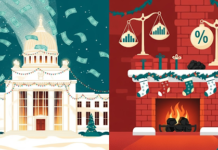Has America Lost Its Shine? Not Really.
Markets have spent the last week behaving like a nervous animal — twitchy, unpredictable, and reacting to every noise. The phrase “Sell America” has crept into reports and strategy memos, raising alarms in both Washington and Wall Street. It’s a rare moment when both the dollar and Treasurys lose footing at the same time — traditionally, at least one stands tall in a storm. But today, it seems even the safest houses are feeling the tremors.
And yet, even amid the fog, the first beams of clarity may be breaking through. A 90-day pause on new tariffs might sound like a half-measure, but markets noticed — rebounding just enough to remind us that sentiment, not certainty, often drives the biggest shifts. While some fear a full retreat of foreign capital, others smell opportunity in the rubble, seeing valuations in companies like Nvidia and long-term bonds as historically attractive.
This week’s Market Pulse digs into the psychology behind volatility, explores what hitting “peak uncertainty” could mean for the road ahead, and asks: what would it really take to steady the U.S. ship? Plus, in This Week I Learned, we’ll share how you can spot generational buying signals using a surprising indicator. And don’t miss The Fun Corner, where we throw a sharp jab at market sentiment — with data to back it up
This Week I Learned…
Why Bears Have Terrible Timing (Historically Speaking)
This week I learned that negative sentiment often precedes major market rebounds.
That’s not just a motivational quote — it’s backed by decades of data. One signal catching a lot of attention this week? The American Association of Individual Investors’ sentiment survey, which just fell to levels not seen since March 2009 and October 1990. If those dates sound familiar, it’s because they mark some of the best long-term buying opportunities in modern market history.
The lesson here is that intense pessimism often serves as a strong contrarian signal. When the majority believes the market is finished, and headlines blare “sell,” long-term investors discreetly make their move. The reason behind this? Panic usually exceeds the actual situation, particularly when fueled by broader concerns such as trade wars or inflation.
Another layer? The Bloomberg Trade Policy Uncertainty Index has just ticked lower for the first time in weeks. A small move, but a significant signal. When uncertainty peaks and begins to ease, investor confidence often follows — even if the headlines haven’t caught up yet.
So next time you see a sea of red and hear whispers of recessions, remember: it might just be the moment opportunity knocks… quietly.
The Fun Corner
Market Myths & Money Matters
Q: What did the bond trader say when asked about their summer vacation plans?
A: “I’m staying liquid this year – the last time I committed to something long-term, the Fed pivoted overnight!”
Jokes aside, there’s a fascinating psychological pattern at work in markets. When certainty feels lowest, that’s precisely when turning points often occur. Consider this: the VIX “fear index” has hit levels above 30 eight times in the past decade. In six of those instances, buying equities within the following month yielded double-digit returns over the next year.
The real lesson? Market timing is notoriously difficult because sentiment extremes rarely align with perfect entry points. And those who wait for “all clear” signals typically miss the most powerful early stages of recoveries.
So perhaps the smartest investors aren’t the ones with perfect timing—they’re the ones who understand that discomfort and opportunity often arrive in the same package.
The ‘Sell America’ Panic: Signal or Noise?
The phrase “Sell America” has gained traction, thanks to a troubling tandem drop in both U.S. Treasurys and the dollar — a rare and unsettling combo that suggests global investors are losing faith in American markets. But is this the start of a structural shift, or a temporary shakeout in sentiment?
At the center of it all is President Trump’s partial pause on tariffs, which provided a glimmer of relief– yet failed to fully reassure markets. Speculation surrounds China and Japan reducing their U.S. debt holdings, despite little concrete evidence. The broader concern? The American investment brand is beginning to show signs of strain.
But smart money is already moving. Jason Browne of Alexis Investment Partners is betting on long-duration Treasurys and bargain tech stocks like Nvidia, a clear sign that some see these valuations as too good to pass up. Meanwhile, UBS and Evercore strategists note that trade-policy uncertainty is beginning to retreat, hinting we may have passed the peak of fear.
Yet the road ahead is anything but clear. With earnings season underway and companies potentially pulling forecasts due to policy uncertainty, volatility remains the name of the game. Analysts caution that any meaningful rebound will require more than a tariff pause — likely including Fed action and regulatory clarity.
Still, the lesson is clear: market sentiment can shift fast, and often before fundamentals do. Whether the “Sell America” narrative sticks or fades, investors should focus less on panic headlines — and more on the signals that matter.
The Last Say
When Panic Becomes a Pattern — and an Opportunity
As today’s newsletter explored, markets aren’t reacting to just policy or fundamentals — they’re reacting to perceptions of fragility. When both Treasurys and the dollar take a hit, it’s more than a blip. It taps into a broader fear: that America’s market dominance may be slipping. But as we’ve also seen, these moments of peak pessimism have often signaled the start of new opportunity cycles.
A slight retreat in trade tensions has helped cool some nerves, but not enough to guarantee stability. The market is still waiting — for earnings clarity, policy direction, and Fed signals. Yet amid the chaos, we see smart investors moving in, not out.
What matters now is how investors manage uncertainty. Those who view downturns as setups rather than setbacks may be positioned to benefit most. If history is any guide, fear has rarely been a sustainable strategy — but resilience and long-term vision often are.























